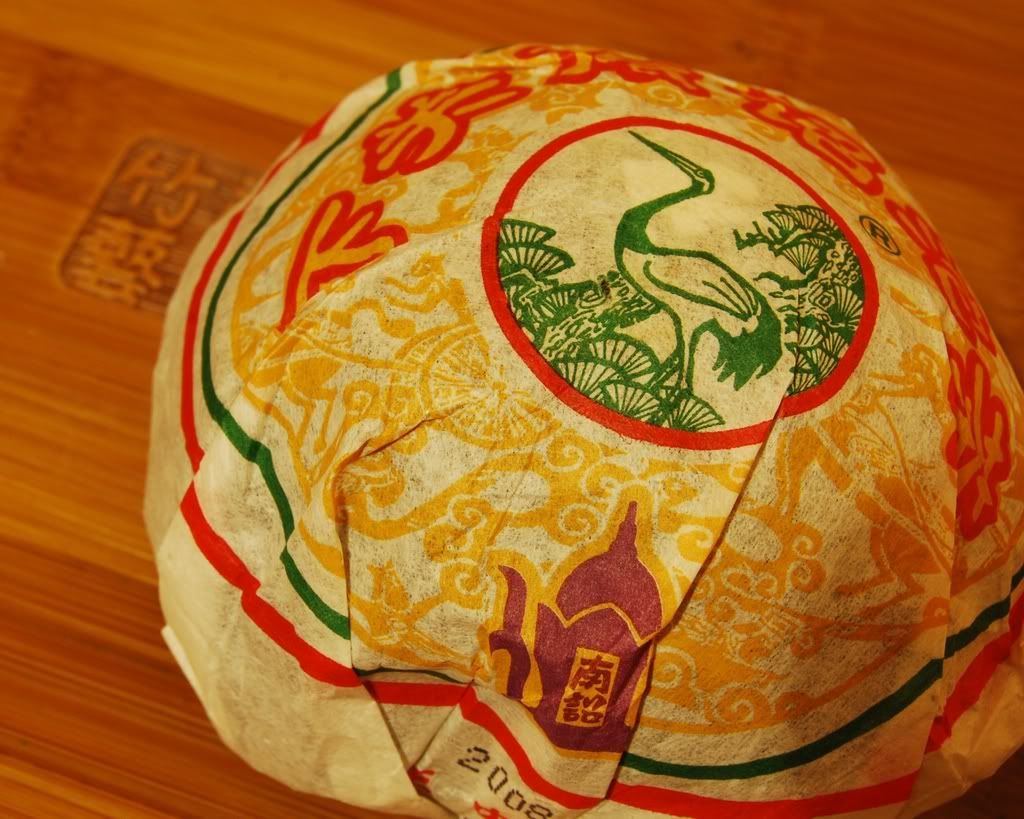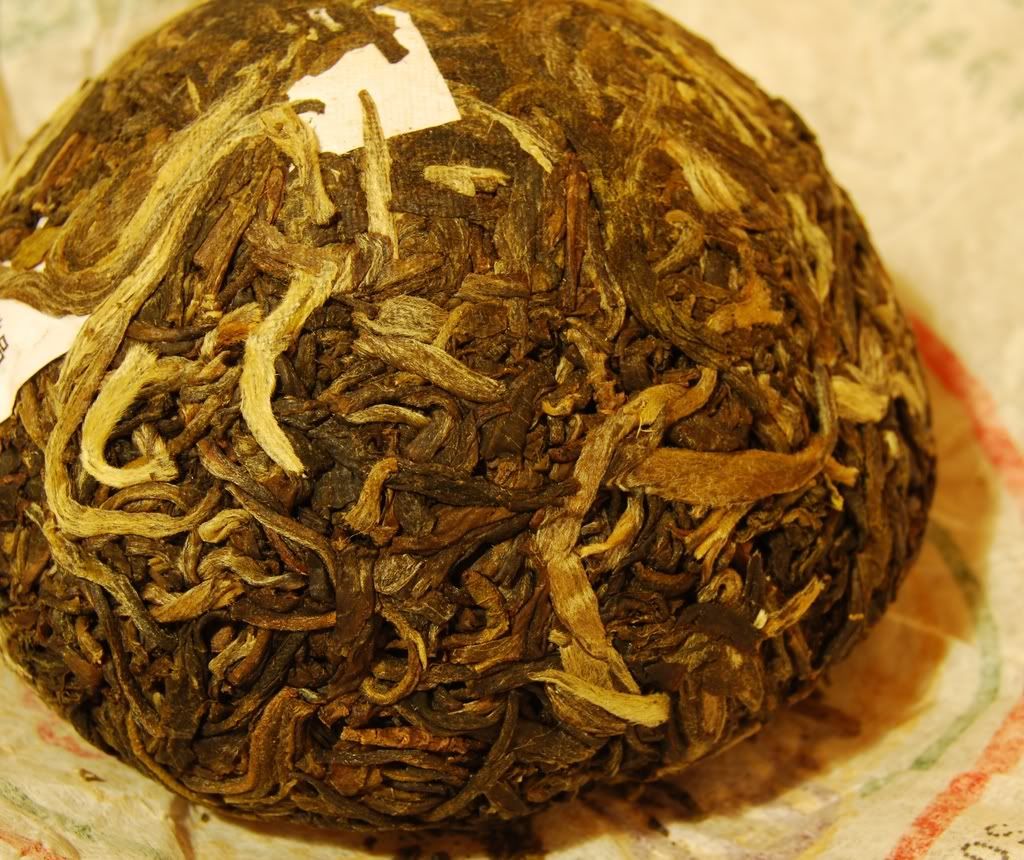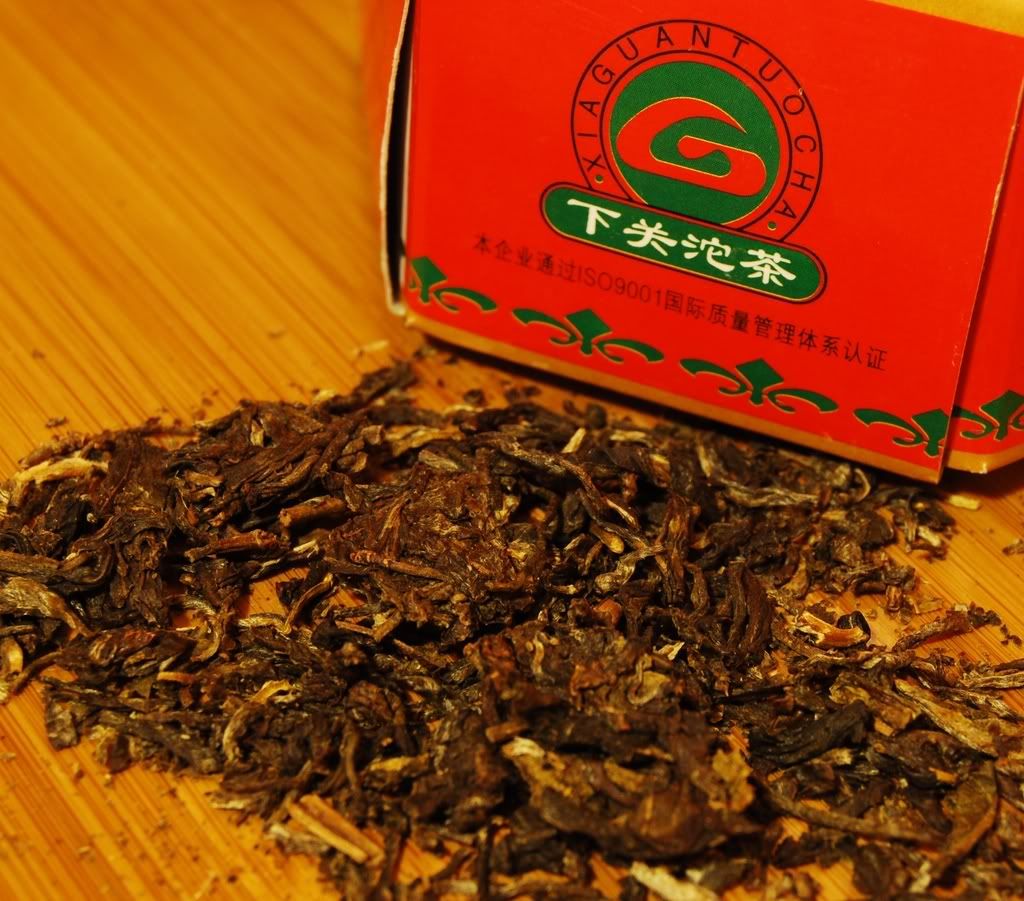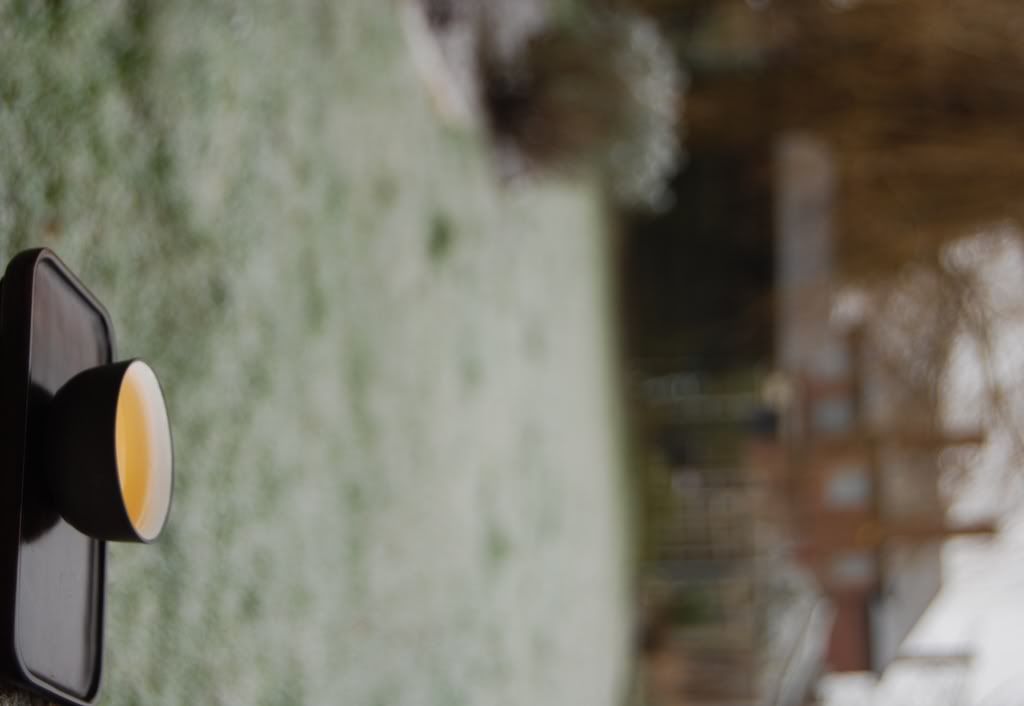In 1992, Xiaguan registered its Songhe brand [SONG-HER, lit. pine-crane, the name of the white bird in the centre of the logo below] and its Nanzhao brand [NAN-DJAO, lit. Southern Edict, referring to the state centred at Dali in Yunnan prior to Chinese rule].
This tuocha has both brands!
It also has the "Big G" logo, usually present on its collectors' teas.
This tuocha has both brands!
It also has the "Big G" logo, usually present on its collectors' teas.

I took these photographs before dawn, and the colour balance is woeful. It's not just galaxies that have red-shift.
I'm sure you remember the 2008 Nanzhao cakes - they were fruity and bitter, in a good way. I rather enjoyed their Baoyan-like darkness, which had been zested up a little. Less tobacco, more fruitiness than Baoyan.
I'm sure you remember the 2008 Nanzhao cakes - they were fruity and bitter, in a good way. I rather enjoyed their Baoyan-like darkness, which had been zested up a little. Less tobacco, more fruitiness than Baoyan.
Pictured below, the tuocha has the same pointless scattering of tips over its surface as do the bingcha. It's all a bit silly - they must have used no more than thirty tip-leaves for this tuocha, and they're all on display in its skin.
The leaves seem a touch smaller than those in the bingcha, matching expectations of Xiaguan tuocha. The high compression means that plenty of fragmentation occurs when you jemmy off nuggets to put into your teapot. The bingcha has the advantage that there is less breakage, though even it has undergone super-high hydraulic compression.
Just like Baoyan, the aroma and flavour are dark and low. Something is afoot in this tea, however. Like the bingcha version, it is fruity. Like the bingcha version, it leaves that aroma now familiar to those of us who have been enjoying the 2007 and 2008 Xiaguan "special" blends: blackness, tobacco, and sweetness.
I've often wondered how that darkness comes about. There are some hints in the flavour: a tell-tale maltiness hangs about its edges reminiscent of Dianhong and other fully oxidised teas.
I've often wondered how that darkness comes about. There are some hints in the flavour: a tell-tale maltiness hangs about its edges reminiscent of Dianhong and other fully oxidised teas.
This tea is not entirely of the "orange" genre, however. I greatly admire both Xiaguan's and Menghai's abilities as blenders of pu'er: this tea contains a proportion of dark, oxidised leaves (perhaps 20-30%, looking at the wet leaves), but the remainder are "normal" shengpu leaves. This gives the whole affair the kuwei [pleasant bitter taste] of fresh tea, and the light, leathery-sweetness of Xiaguan / Dali leaves, while giving some extra depth courtesy of the dark, tobacco-like characteristics presumably introduced by the darker leaves.
I'm just guessing, of course. I'd really love to spend some time at Xiaguan HQ finding out what's really happening.
I'm just guessing, of course. I'd really love to spend some time at Xiaguan HQ finding out what's really happening.
Ultimately, "orange" teas have had something removed by design in order to make them palatable. It could be that this artificial removal (such as by letting a proportion of the leaves oxidise prior to shaqing) reduces their long-term performance. We might imagine that removal of compounds from the leaf, in order to introduce characteristics associated with age (woodiness, richness), might prevent there being enough content to truly age into something splendid. Who knows.
To that end, I think I've got enough "drink-it-now" Xiaguan tea, and I am consciously slowing my purchasing of new Xiaguan blends. Ironically, it could be those plain, potent non-FT tuocha that turn out to be best in the long-run, while these initially appealing Nanzhao / FT productions turn out less well. It'll be fun finding out, anyway. Such is the beauty of pu'er.
To that end, I think I've got enough "drink-it-now" Xiaguan tea, and I am consciously slowing my purchasing of new Xiaguan blends. Ironically, it could be those plain, potent non-FT tuocha that turn out to be best in the long-run, while these initially appealing Nanzhao / FT productions turn out less well. It'll be fun finding out, anyway. Such is the beauty of pu'er.






Yeah, I,m pretty much in the same boat as you with the Xiaguan special productions. Ive enjoyed all of them, they are good. But Ive had enough. Variations on a theme. If youve had one of the FT,s you kinda have had them all. But I,m sticking to my guns with the #4, so good it makes me want to hit somebody.
ReplyDeleteSlap a relative maybe, Bret ;)? Just kidding.
ReplyDeleteVery interesting discussion on the possible drawbacks of manufacturing drink-now pu. Fascinating that the tuo is not an exact replica flavor wise of the bing.
Hobbes do you really want to visit the Xiaguan HQ? You may not like what you find ;)!
Have a good one,
Alex
Hey, it's missing the "horse's back" logo.
ReplyDeleteDear Bret,
ReplyDeleteI must remember to try that #4 again, thank you!
Dear Alex,
You're probably right! I suspect I'd not find anything out, anyway, but it'd be nice to try. :)
Dear Tony,
Collect the set! I reckon some of the FT teas will get there, and have all Xiaguan logos on them before long. :)
Toodlepip all,
Hobbes
It just occured to me that you (Hobbes) being in the U.K. may not know what the joke is with the whole hit somebody thing. There is a spice mixture from Louisiana that,s called "Slap Yo Momma" their slogan is that it,s so good it,ll make you wanna "Slap Yo Momma" Must be good if it inspires violence. haha
ReplyDeleteI think Hoobes is familiar with physical expressions of
ReplyDeletejoy (just read from post #1026 on ;))
I guessed! but thanks ;)
ReplyDeleteTo Hobbes
ReplyDeleteYou write that this one has some similarities with the great FT Baoyan Jin Cha, and I was wondering if you had any experience with the regular Xiaguan "Holy Flame" mushroom - do you think I should dare one of the "Holy Flame" sheng mushrooms or even the bricks? I've also noticed that Gouyan has a Tibetian mushroom; have you tasted this?
"I've often wondered how that darkness comes about. There are some hints in the flavour: a tell-tale maltiness hangs about its edges reminiscent of Dianhong and other fully oxidised teas."
ReplyDeleteYou are right on. Xiaguan formula does contain certain amount Dianhong and Green Tea - to the extend that Xiaguan openly admits their teas are not 'Puer'!
Yet the point is that Xiaguan has produced so many successful 'Puer' teas as we knew.
Jim
Puerh Shop
Visiting the tea factory to find out what they're doing. Not gonna happen. Sure, there are some things they'll let you see. But no, none of us are the chosen ones meant to find out the secret. And I don't think there's anything so wrong with that, considering that even Pu-erhs that pretend to be higher quality are actually still real Pu-erhs. --Teaternity
ReplyDelete